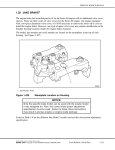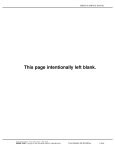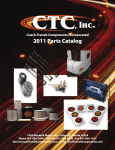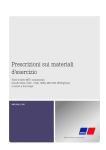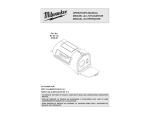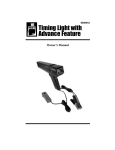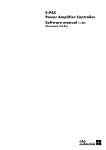Download Detroit Diesel 60 Specifications
Transcript
DETROIT DIESEL SERIES 60 ENGINE OWNERS MANUAL CONTACT FITZGERALD GLIDER KITS 1225 Livingston Hwy Byrdstown, TN 38549 Monday–Friday, 8am–5pm (CST) Toll Free: (888) 649-1053 Sales: (931) 864-4885 Warranty: (931) 864-4886 FAX: (931) 864-4895 www.fitzgeraldgliderkits.com ENGINE MODEL AND SERIAL NUMBER DESIGNATION The engine serial number and model number are stamped on the cylinder block in the following location (as viewed from the flywheel end): Left side just below the intake manifold and above the cast-in Detroit Diesel logo. Location of Engine Serial and Model Numbers 1 DDEC II NOTICE: Detroit Diesel Series 60 engines equipped with DDEC II electronic control systems are identified by a “U” in the sixth position of the model number. Example: 6067GU60. Detroit Diesel Electronic Controlled Series 60 engines can be equipped with a variety of options designed to warn the operator of an engine malfunction. The options can range from “Check Engine” and “Stop Engine” panel lights to automatic reduction in engine power followed by automatic engine shutdown. The power-down/shutdown option may be activated by low coolant level, low oil pressure, or high engine oil or coolant temperature. If the warning lights stay on, or if they do not come on momentarily after turning on the ignition, consult with a DDEC technician. Operating the engine under these circumstances may result in engine damage. The Series 60 DDEC engine is equipped with an electronically controlled fuel injection system. There are no control racks or mechanical linkage to adjust. This system not only helps to improve fuel economy and vehicle performance, but also helps to reduce cold starting time and increase initial idle speed for fast engine warm-up and DDEC III/IV virtual elimination of cold smoke. The DDEC engine has no mechanical Detroit Diesel Series 60 engines equipped with governor. Engine horsepower, torque, idle, DDEC III or DDEC IV electronic control systems and engine speed are contained in the are identified by a “K” in the sixth position of internal electronics. Therefore, there are no the model number. Example: 6067GK60. mechanical governor spring adjustments for Detroit Diesel Electronic Controlled Series idle and high speed control. 60 engines can be equipped with a variety of There is no need for a throttle delay options designed to warn the operator of an either, since emission control is performed engine malfunction. The options can range through the Electronic Control Module (ECM). from “Check Engine” and “Stop Engine” panel The Electronic Foot Pedal Assembly (EFPA), lights to automatic reduction in engine power eliminates the need for any throttle linkage. followed by automatic engine shutdown. The DDEC engine has the ability to The power-down/shutdown option may be perform diagnostics for self-checks and activated by low coolant level, low oil pressure, continuous monitoring of other system or high engine oil or coolant temperature. components. Depending on the application, DDEC can also monitor oil temperature, coolant temperature, oil pressure, fuel pressure, coolant level, and remote sensors (if used). This diagnostic system is connected to the “Check Engine” light (CEL) and the “Stop Engine” light (SEL) to provide a visual warning of a system malfunction. Typical Shut-Down Override Switch and Engine Lights 2 DDEC III/IV ENGINE PROTECTION The immediate speed reduction option will bring engine RPM back to a predetermined speed, but will not shut down the engine. The engine should not be restarted after it has been shut down by the engine protection system unless the problem has been located and corrected. The conditions that will cause the “Stop Engine” light to come on are: Since many vehicles are equipped with the DDEC engine protection system, the “Stop Engine” malfunction is recorded in the Electronic Control Module. With the 30 second shutdown option, the engine will begin a 30 second stepped power down sequence until it shuts down completely. To allow for the possibility of the “Stop Engine” automatic shutdown function being activated while the vehicle is operating in a critical situation, an override is provided. In such a situation the operator may elect to “override” the automatic stop engine sequence by pressing the “Stop Engine Override” switch, located on the instrument panel, until a safe stop can be made. The operator only needs to press the override switch every 15 to 20 seconds to prevent the engine shutdown from occurring. An important thing to remember is that it takes 30 seconds from the time the automatic shutdown sequence begins until engine shutdown. Therefore the operator must press the override switch just prior to engine shutdown and continue to do so until the vehicle can be brought to a safe stop. ■ Loss of coolant ■ High oil temperature ■ Low oil pressure ■ Auxiliary shutdown It is important to point out that whenever the CEL or the SEL comes on, the DDEC computer will determine where the problem is, and will then store this information in its memory. If the malfunction is intermittent, the lights will come on and go off as the computer senses the changing engine condition. A special diagnostics tool (Diagnostics Data Reader, or “DDR”) is available that can be plugged into the engine computer memory to extract information related to the cause of the problem. 3 EMERGENCY JUMP STARTING Once the malfunction has been corrected, the DDEC system will return the engine to normal operation. The DDR can distinguish between codes now active and those stored in the historic code memory. The malfunction code recorded in the computer memory will remain until it is erased by a technician. The malfunction code can also be obtained by the operator. A “Diagnostic Request” switch may be provided which, when pressed, will cause the CEL to flash a code number. It will, for example, flash twice … pause … flash five times … pause. In other words a code 25. Code 25 will continue to flash and repeat as long as the check engine switch is held in the “On” position with the ignition on. The DDEC II electronic control system operates on 12 volt DC. If a DDEC II engine with an electronic starting motor requires emergency jump starting, do not exceed 16 volts DC. DDEC III and DDEC IV electronic control systems operate on 12 or 24 volts DC. If a DDEC III or DDEC IV engine with an electronic starting motor requires emergency jump starting do not exceed 32 volts DC. NOTICE: Jump starting with voltages greater than those indicated or reversing battery polarity may damage the ECM (Electronic Control Module). 4 DDEC II Diagnostic Codes Diagnostic Connector TO READ CODES: Use diagnostic data reader or short pin A to pin M. The latter method will flash codes at the CEL. Error Code # 11 12 13 14 15 16 21 22 23 24 25 26 31 32 33 34 35 36 37 38 41 Error Code # 42 43 44 45 46 47 48 51 52 53 54 55 56 58 61-68 71-78 84 85 86 87 Description Power Take-off Sensor Lo Volt Power Take-off Sensor Hi Volt Coolant Sensor Lo Volt Eng Temp Sensor Hi Volt Eng Temp Sensor Lo Volt Coolant Sensor Hi Volt Throttle Pos Sensor Hi Volt Throttle Pos Sensor Lo Volt Fuel Temp Sensor Hi Volt Fuel Temp Sensor Lo Volt No Codes Power Control Enabled Fault on Auxiliary Output ECM Backup System Fail Turbo Bst Sensor Hi Volt Turbo Bst Sensor Lo Volt Oil Prs Sensor Hi Volt Oil Prs Sensor Lo Volt Fuel Prs Sensor Hi Volt Fuel Prs Sensor Lo Volt Timing Reference Sensor Description Synchronous Ref Sensor Low Coolant Level Engine Over Temperature Low Oil Pressure Low Battery Voltage Hi Fuel Pressure Lo Fuel Pressure EEPROM Error ECM - A/D Fail EEPROM Memory Failure Vehicle Speed Sensor Proprietary Comm. Link ECM - A/D Fail Cruise Ctl/Press Gov Ctl Switch Inj Response Time Long Inj Response Time Short Crankcase Pressure Hi Engine Overspeed Press Gov Ctl - Hi Volt Press Gov Ctl - Lo Volt CEL Examples CEL 1 Flash CEL 3 Flashes Short Pause 2 Flashes Long Pause Code 13 1 Flash Short Pause Code 21 NOTE: The CEL flashing gives both active and inactive (historic) codes. 5 DDEC III/IV Diagnostic Codes Flash Code 11 12 13 14 15 16 17 18 21 22 23 24 25 26 27 28 31 32 33 34 35 36 37 38 41 42 43 Flash Code 44 45 46 47 48 52 53 54 55 56 57 61 62 63 64 65 66 67 68 71 72 73 74 75 76 77 85 86 87 DDEC III/IV Description VSG Sensor Input Voltage Low VSG Sensor Input Voltage High Coolant Level Sensor Input Voltage Low Oil or Coolant Temp. Sensor Input Voltage High Oil or Coolant Temp. Sensor Input Voltage Low Coolant Level Sensor Input Voltage High Throttle Valve Position Sensor Input Voltage High Throttle Valve Position Sensor Input Voltage Low TPS Input Voltage High TPS Input Voltage Low Fuel Temp. Sensor Input Voltage High Fuel Temp. Sensor Input Voltage Low No Active Codes Aux. Engine Shutdown #1 or #2, Input Active Air Inlet or Intake Air, Temp. Sensor Input Voltage High Air Inlet or Intake Air, Temp. Sensor Input Voltage Low Aux. High Side Output Open Circuit or Short to Ground CEL or SEL Short to Battery (+) or Open Circuit Turbo Boost Sensor Input Voltage High Turbo Boost Sensor Input Voltage Low Oil Pressure Sensor Input Voltage High Oil Pressure Sensor Input Voltage Low Fuel Pressure Sensor Input Voltage High Fuel Pressure Sensor Input Voltage Low Too Many SRS (Missing TRS) Too Few SRS (Missing SRS) Coolant Level Low DDEC III/IV Description Oil or Coolant or Intake Air, Temp. High Oil Pressure Low ECM Battery Voltage Low Fuel, Air Inlet, or Turbo Boost Pressure High Fuel or Air Inlet Pressure Low ECM A/D Conversion Fail ECM Non Volatile Memory Fault Vehicle Speed Sensor Fault J1939 Data Link Fault J1587 Data Link Fault J1922 Data Link Fault Injector Response Time Long Aux. Output Short To Battery (+) or Open Circuit, or Mech. Fault PWM Drive Short to Battery (+) or Open Circuit Turbo Speed Sensor Input Fault Throttle Valve Position Input Fault Engine Knock Sensor Input Fault Air Inlet Pressure Sensor Input Voltage Fault TPS Idle Validation Switch Open Circuit or Short to Ground Injector Response Time Short Vehicle Overspeed Gas Valve Position Input Fault or ESS Fault Optimized Idle® Safety Loop Short to Ground ECM Battery Voltage High Engine Overspeed with Engine Brake Fuel Temperature High Engine Overspeed External Pump Pressure Sensor Input Voltage High External Pump Pressure Sensor Input Voltage Low TO READ CODES: Use the diagnostic data reader or depress and hold the diagnostic request switch with the ignition on, engine at idle or not running. Press and hold the switch. Active codes will be flashed on the “Stop Engine” light (SEL) followed by the inactive codes being flashed on the “Check Engine” Light (CEL). The cycle will repeat until the operator releases the diagnostic request switch. 6 S-60 ENGINE DRIVING TIPS ACCELERATING THE VEHICLE The cruise light will come on. To increase road speed in one MPH increments, press the resume/accel switch. To reduce speed, press and hold the set/coast switch until the lower speed is reached. Cruise control is deactivated by slightly depressing the service brake, clutch pedal, or trailer brake. Also, the on/off switch deactivates cruise control. Cruise control will maintain speed even on upgrades, unless power requirements demand a downshift. And, of course, cruise control doesn’t limit your speed on downgrades. Most likely, the cruise control will feel stronger than driving with the foot pedal because of the instantaneous and wide open throttle response. That is why cruise control is not suggested during slippery conditions. Use cruise control after downshifting on a hill to pull the hill. Hitting the resume switch (not the set switch) will keep the truck accelerating in the lower gears up to rated engine speed. Cruise control will disengage below 1100 RPM or 20 MPH road speed. If you want to pull the engine below 1100 RPM when using cruise control, remember to hold the throttle pedal to the floor to keep the engine pulling at wide open throttle. Realistically, the engine will pull to about 1050 RPM. Remember: the electronic data programmed into the ECM will not allow you to hurt or overfuel the engine at low or lug speeds. There is enough oil pressure to withstand hard pulls at low engine speeds. Engine response versus pedal movement may feel different from the mechanical governed engine you were driving. The electronic foot pedal assembly was designed to communicate “percentage” foot pedal travel to the engine’s electronic control module. The engine will respond accordingly to the driver’s demand. Another throttle or governor characteristic you may need some time to get used to the DDEC limiting speed governor. This allows the driver to command total engine response between idle and rated speed, such as accelerating at half throttle—an advantage when driving under slippery conditions. If you do require wide open throttle engine response, either accelerating or just plain pulling hard, the throttle will have to be held to the floor. To obtain 100% fueling at any speed, the foot pedal will have to be maintained at the fully depressed position. CRUISE CONTROL For added driver convenience and comfort, DDEC III also features a cruise control option which works just like the system in your car. It can be operated in any gear above 1100 RPM or road speed faster than 20 MPH, up to the rated engine speed. It can be programmed to hold your road speed at or below the maximum vehicle speed. The switch to energize cruise control is usually mounted on the instrument panel. Turn the switch to the on position to energize the system. When you reach road speed, press the set switch to activate cruise control. 7 S-60 ENGINE DRIVING TIPS JAKE BRAKES almost as if it had quit pulling. Don’t believe it! if you had a boost gauge to look at while driving, you would notice the turbocharger maintaining steady intake manifold pressure, even as RPM’s fall. Depending on the air intake arrangement, you may also experience a “chuffing” sound as the engine starts to pull hard at the lower RPM’s. This is caused by the velocity changes of the airflow within the air intake plumbing. Electronic engines can actually deliver more fuel at lower engine speeds than rated speed. If your engine is equipped with both cruise control and Jake Brake® retarders, the Jakes can operate automatically while you are in cruise control. If the cruise control/ engine brake function is turned on in the ECM programming, the Jakes will come on “low” when your set road speed increases a few MPH or KPH above your set cruise speed. If your speed continues to increase, the ECM will increase the Jakes’ braking power progressively. When the vehicle returns to the set cruise speed, the Jakes will “turn off” until the next time you need them. For safety reasons, don’t use cruise control when it’s not possible to keep the vehicle at constant speed due to winding roads, heavy traffic, slippery roads, or when descending grades that call for Jake Brake® assistance. IDLE REQUIREMENTS If you have to idle your engine for any reason, it is suggested that RPM’s be set at 900 to 1000 RPM. Try to minimize idle times as much as possible for the first 10,000 miles on the engine. Lower idle RPM’s will cause oil slubber, and can inhibit the cylinder rings’ ability to seat properly. SHIFTING IDLE SHUTDOWN Depending on your transmission model, the gear split may vary from 500 to 300 RPM. The electronic governor provides almost no overrun capability, and if the transmission is downshifted too early, you will experience a temporary loss of pulling power until the engine speed falls below rated speed. This is true even on steep grades with heavy loads. When using an 18, 15 or 13 speed transmission, you will need to downshift at an RPM that allows “less than rated” RPM before throttle application in the next gear down. You may want to limit engine speed to 1900 RPM in all gears. The Series 60 provides constant horsepower from 1800 RPM through 2100 RPM, but fuel economy is not as efficient above 1800 RPM and may cause premature engine issues and/or failures. If you decide to drive at lower RPM’s for improved fuel economy, don’t let different engine noises throw you off guard. The Series 60 sounds quiet at 1400 RPM, The DDEC engine may also have an optional idle shutdown system. The purpose of this system is to conserve fuel by eliminating excessive idling and to allow for a turbocharger cool down period. To activate the shutdown, the transmission must be in neutral with the vehicle parking brakes set and with the engine in idle or fast idle mode. The cruise control system may also be programmed to permit fast idle using the cruise control switches. With the engine at normal idle, the transmission in neutral, and the service brake on, turn on the cruise control “on/off” switch, and use the “Resume” switch. The engine RPM should increase to a predefined RPM. The RPM can be raised or lowered from this point using the “set” and “resume” switches. 8 FITZGERALD WARRANTY STATEMENT Fitzgerald Glider Kits is not responsible for the cost of maintenance or repairs due to lack of performance of required maintenance services or the failure to use Fuel, Oil, Lubricants, and coolants meeting Detroit Diesel recommended specifications. Performance of said required maintenance and use of proper fuel, oil, lubricants and coolants are the responsibility of the owner. CODES: I–Inspect, Service, Correct or Replace as Necessary. R–Replace 9 LUBRICANT SELECTION IN NORTH AMERICA LUBRICANT REQUIREMENTS The selection of the proper lubricating oil is important to achieve the long and trouble-free service which Detroit Diesel engines are designed to provide. The proper lubricating oil for all Detroit Diesel engines is selected based on SAE viscosity grade and API (American Petroleum Institute) service designation. Only oils licensed to display the American Petroleum Institute (API) symbol shown should be used. Lubricants meeting these criteria have provided maximum engine life when used in conjunction with specified oil drain and filter maintenance schedules. SAE Viscosity Grade: 15W-40 API Classification: CH-4–CJ-4 HT/HS Viscosity: 3.7 cP minimum The preferred lubricating oil is Shell Rotella SAE 15W-40 (CJ-4). (P/N 23512703) API Lubricant Service Mark SYNTHETIC OIL OIL DRAIN INTERVALS Synthetic oils may be used in Detroit Diesel engines, provided they are approved by a Power Guard Oil Specification. The use of synthetic oil does not necessarily ensure the extension of the recommended oil drain interval beyond its limits. During use, engine lubricating oil undergoes deterioration from combustion byproducts and contamination by the engine. In addition, certain components in a lubricant additive package are designed to deplete with use. For these reasons, regardless of the oil formulation, regular oil drain intervals are required. Fitzgerald Glider Kits recommends first initial oil change at 5,000 to 7,000 miles to remove breakin metals and rebuild contaminates. Oil should be changed every 15,000 miles thereafter. 10 LUBRICATING OIL CHECKS NOTICE: Check the oil level daily with the engine stopped. If the engine has just been stopped and is warm, wait approximately 20 minutes to allow the oil to drain back to the oil pan before checking. Add the proper grade of oil to maintain the correct level on the dipstick. Do not overfill. Oil may be blown out through the crankcase breather if the crankcase is overfilled COOLANT Check Oil Level Daily All diesel engines are designed to use some oil, so the periodic addition of oil is normal. See “Engine Oil Consumption Guidelines” to determine the degree of oil usage. Shell Rotella ELC Engine Coolant is the preferred ethylene glycol coolant. If other commercial brands of ethylene glycol are used, they must be equivalent to the Shell Rotella ELC. ENGINE OIL CONSUMPTION GUIDELINES *SERVICE IS RECOMMENDED HIGH SLIGHTLY HIGH NORMAL MILES PER QUART Kilometers = miles x 1.6. For off-highway applications, 1 hour = 33 miles. *Have your engine serviced by an authorized Detroit Diesel service facility at the earliest opportunity. Conventional Coolant (commonly green) Test at every service using Pencool or Power Cool test strips. Any additive supplements should be Power Cool or Pencool. Fully Formulated (commonly red or purple) Test at every service. Repeat steps mentioned above. Extended Life Coolant (commonly red or pink) Check freeze point at every service. Requires an enhancer at 325,000 miles. Refer to decal on coolant reservoir. 11 LOW SUPPLEMENTAL COOLANT ADDITIVE (SCA) TEST PROCEDURES Wait at least 60, but no longer than 75, seconds before reading the nitrite level. Promptly replace and tighten the test strip container cap after each use. Discard unused strips if they have turned light pink or tan. A factory analysis program is available through authorized Detroit Diesel service outlets. To verify coolant acceptability, submit a sample for coolant analysis every three (3) years, 300,000 miles, (480,000 km), or 6,000 operating hours, whichever comes first. If any other coolant additive is used, follow that particular manufacterers guidlines. Pencool 3-Way Coolant Test Strips should be used to measure nitrite and glycol concentrations. Cavitation/corrosion protection is indicated on the strip by the level of nitrite concentration. Freeze/boilover protection is determined by glycol concentration. Use the test strips as follows: 1. Dip the strip into coolant for one second. Remove and shake briskly to eliminate excess fluid. NEED RELEASE COOLANT FILTERS 2. Immediately compare end pad(% Glycol) to the color chart on the container. 3. Sixty seconds (one minute) after dipping, compare the nitrite pad to the color chart. Spin-on coolant filters are available for Detroit Diesel engines. Membranes in the filters release SCAs before the coolant approaches a corrosive condition, protecting the engine from corrosion. The elements release the SCA charge as needed, as opposed to the maintenance SCA elements, which instantaneously release the SCA charge. These elements should be replaced after 1 year, 120,000 miles, (192,000 km), or 2,000 operating hours, whichever comes first. 4. Color change of additive indicator (middle pad) indicates presence of inhibitor that is not approved by Detroit Diesel. For best results make the tests while the coolant is between 50ºF–120ºF (10.ºC–60ºC). 12 FUEL PROCESSORS DIESEL FUEL Many vehicles are now equipped with optional fuel processors, such as Detroit Diesel’s Fuel Pro 382. This single filter system replaces traditional primary and secondary filters. By reducing the number of filters and extending the change interval, filter expense can be reduced by up to 75%. The quality of fuel used in the Detroit Diesel engine is a very important factor in obtaining satisfactory engine performance, long engine life and long injector life. Biodiesel fuels can decrease the life of fuel filters and degrade their water coalescing ability. Failures attributed to the use of fuels which do not meet industry standards are not the fault of Fitzgerald Glider Kits, and will not be covered by Fitzgerald Glider Kits warranty. Fitzgerald Glider Kits recommends using a 7 to 10 micron filter. Using a 7 micron filter will increase filter change frequency, but will provide better protection for the injectors Here is how the Fuel Pro 382 works: Clean 50% 75% 100% 3. Restriction remains consistently low. Even though the fuel level is now over more than half of the element, the fuel is still flowing through clean new media. 1. When new, the fuel level in the 382 filter will be very low. The filter is causing minimal restriction. as the filter used in Model 382, dirt collects on the filter from the bottom up. Fuel rises on the filter indicating remaining filter life. 4. The filter element is now covered by fuel, and it is using all of the media’s surface area. Restriction is just starting to rise and the element should be changed at the next scheduled maintenance interval. 2. Fuel level remains low. As dirt is trapped on the filter, the fuel rises over the dirt and flows through clean filter media to keep flow restriction low. NOTE: If your vehicle is not equipped with a Fuel Pro, retrofit kits are available from DDC outlets. 13 AFTERMARKET FILTRATION PARTS LIST FOR OUR SYSTEMS 6067GK60 MODEL ENGINES ONLY Aftermarket Fuel supplemental filtration systems may be used, provided they do not replace the factory installed system, reduce fuel volumes, pressures, or flow rates delivered to the engine. ADDITIONAL MAINTENANCE ITEMS: Detroit Fuel Filter 23538657 Luber Finer Oil Filter LFP2160 Borg Warner Turbo 171702 Water Pump R23522707 InjectorsR23555915 Transmission: 50wt synthetic oil drain/flush at 500,000 miles Differential: 75w90 synthetic oil drain/flush at 500,000 miles Power Steering filter change interval: Once a year. Service Eaton “Easy Pedal” clutches based on manufacturers recommendations. Cam Sensor 8929387 Crank Sensor 8929388 Oil Pressure Sensor 23532797 7 Micron Filter 23521528 10 Micron Filter 23533816 Other engine model componants will vary. (6067WK60, 6067BK60). *Freightliner Cascadia’s use “solo” clutches. Follow manufacturers recommendations. OVERHEAD SETTINGS If your suspension does not have grease fittings, it is a sealed, maintenance free system. Contact manufacturers for recommendations. As previously stated, Fitzgerald Glider kits recommends that the overhead be run at 60,000 miles to ensure peak performance out of your 12.7 litre Detroit Diesel engine. Our overhead settings are as follows: Fitzgerald Glider Kits does not align front ends or balance tires. This will be the owners responsibility. Fitzgerald Glider Kits reserves the right to ship parts to customers or repair shop. Certain parts are specific to our engines and not readily available at most shops. Any parts shipped that require special paint colors will delay shipping. 14 Intake: 8 Exhaust: 26 Jake: 26 Injector: 80.3mm FITZGERALD GLIDER KITS WARRANTY INFORMATION Do Not Perform Repairs On This Vehicle Until Making Contact With Our Warranty Department.” It also includes our phone number, displayed for contact. You may instruct the shop before hand of this, and expedite this process somewhat if you choose. Not following this procedure may jeopardize your warranty availability and increase your out-of-pocket expense. We will give the shop permission to now diagnose your problem, and in turn give us an estimate for parts and labor of the repair. After we receive this estimate, we will review it and make sure labor times are within Motor Manual SRT Guidelines. We will also evaluate the parts required to determine if the parts are something that can be purchased there, or if they need to be shipped from our facility. Our department staff will stay in close contact with the repair shop throughout the repair process, and will give you, the customer, updates as often as you request. As a customer of Fitzgerald Glider Kits, we would like to take a moment to explain and make you familiar with our warranty process. We will break this down in 5 steps. Step 1. Contact We may be contacted at 866-597-3836 or 931-864-4886, Monday through Friday from 8:00am to 5:00pm CST. After hours we may be reached at 931-337-5794, Monday through Friday from 5:00pm to 8:00pm CST, and Saturday from 8:00 to 12:00pm CST. Step 2. Repair facility When a problem does arise with your Glider, please contact this warranty department first. This will allow our involvement and guidance from the beginning, which will make for a more pleasant experience for us all during this process. Fitzgerald Glider Kits warranty department would like to remind you, that while every effort will be made by our staff to see that your truck is repaired correctly and in a timely manner, we are not a breakdown service. Upon receiving your call, we will assess the issue, and guide you towards a facility to make the necessary repair. Due to certain parts specific warranty policies, (such as; OEM, Eaton, Bendix, Etc.), some repairs must be made at the facilities that can file warranties through these companies. Otherwise, the warranty for repairs will not be available, and will result in out-of-pocket expenses. Our department will guide you in this process and make you aware of their locations. Step 4. Billing After the repair is completed, Fitzgerald Glider Kits will pay the final invoice for all agreed upon warranty items from the estimate. Step 5. Completion Now that the repair has been completed and the invoice is paid, you can get your truck back into service, which is WHY you made the purchase in the first place. This will be the process that you will use any time there is a warranty issue. Please feel free to call our warranty department with any questions you may have about your truck warranty. We are here to help you make your experience with our warranty as pleasant as possible, and to keep your truck in service and remain profitable. Step 3. Repairs NOTE: Custom painted engine parts will require and extra day of shipping due to painting. After you have contacted us and now have your truck at a repair shop, it is time for the repair. The shop will notice a distinctive decal on your engine valve cover. It says “STOP! 15 YOUR FITZGERALD GLIDER KIT WITH DETROIT SERIES 60 ENGINE When your Fitzgerald Glider Kit leaves our factory floor it is filled with the following fluids: Shell Rotella SAE 15W-40 (CJ-4) motor oil Peak windshield washer fluid Shell Spirax S6 GME 50wt. synthetic transmission oil Syngard 75w90wt. synthetic differential oil Antifreeze: Shell Rotella ELC 50/50 Antifreeze 16 NOTES: NOTES: NOTES: NOTES: DETROIT DIESEL SERIES 60 ENGINE























